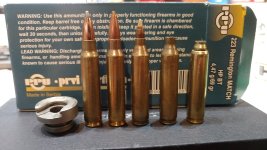FrankenMauser
New member
Most of my "wildcats" are no longer wildcats. They're still fairly uncommon, but most are now standardized. -- Such as 6x45mm and .35 Whelen.
I think the only two left unstandardized are .17-223 and .475 Tremor.
.475 Tremor is .458 SOCOM necked up to take advantage of .480 Ruger / .475 Linebaugh bullets (which are better suited to the achieved velocities than the .458" rifle bullets commonly available for the .458 SOCOM).
.17-223 is just that: .223 Rem necked down to .17 caliber while maintaining the same shoulder (23.5 degrees, I believe?)
It looks more ridiculous in person than in this photo:
Left to right: 6x45mm w/ 80 gr SP, .223 Rem w/ 69 gr HPBT, .17-223 w/ 17 gr Remington Accu-Tip, .17-223, and a case that folded during forming.

I think the only two left unstandardized are .17-223 and .475 Tremor.
.475 Tremor is .458 SOCOM necked up to take advantage of .480 Ruger / .475 Linebaugh bullets (which are better suited to the achieved velocities than the .458" rifle bullets commonly available for the .458 SOCOM).
.17-223 is just that: .223 Rem necked down to .17 caliber while maintaining the same shoulder (23.5 degrees, I believe?)
It looks more ridiculous in person than in this photo:
Left to right: 6x45mm w/ 80 gr SP, .223 Rem w/ 69 gr HPBT, .17-223 w/ 17 gr Remington Accu-Tip, .17-223, and a case that folded during forming.

